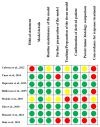Endometrial Cancer Patient-Derived Xenograft Models: A Systematic Review
- PMID: 35566732
- PMCID: PMC9100787
- DOI: 10.3390/jcm11092606
Endometrial Cancer Patient-Derived Xenograft Models: A Systematic Review
Abstract
Background: Because patient-derived xenograft (PDX) models resemble the original tumors, they can be used as platforms to find target agents for precision medicine and to study characteristics of tumor biology such as clonal evolution and microenvironment interactions. The aim of this review was to identify articles on endometrial cancer PDXs (EC-PDXs) and verify the methodology and outcomes.
Methods: We used PubMed to research and identify articles on EC-PDX. The data were analyzed descriptively.
Results: Post literature review, eight studies were selected for the systematic review. Eighty-five EC-PDXs were established from 173 patients with EC, with a total success rate of 49.1%. A 1-10 mm3 fragment was usually implanted. Fresh-fragment implantation had higher success rates than using overnight-stored or frozen fragments. Primary tumors were successfully established with subcutaneous implantation, but metastasis rarely occurred; orthotopic implantation via minced tumor cell injection was better for metastatic models. The success rate did not correspond to immunodeficiency grades, and PDXs using nude mice reduced costs. The tumor growth period ranged from 2 weeks to 13 months. Similar characteristics were observed between primary tumors and PDXs, including pathological findings, gene mutations, and gene expression.
Conclusion: EC-PDXs are promising tools for translational research because they closely resemble the features of tumors in patients and retain molecular and histological features of the disease.
Keywords: PDX; endometrial cancer; patient-derived xenograft.
Conflict of interest statement
The authors declare no conflict of interest.
Figures



Similar articles
-
Patient-Derived Xenograft Models in Cervical Cancer: A Systematic Review.Int J Mol Sci. 2021 Aug 29;22(17):9369. doi: 10.3390/ijms22179369. Int J Mol Sci. 2021. PMID: 34502278 Free PMC article.
-
Patient-Derived Xenograft Models for Translational Prostate Cancer Research and Drug Development.Methods Mol Biol. 2024;2806:153-185. doi: 10.1007/978-1-0716-3858-3_12. Methods Mol Biol. 2024. PMID: 38676802
-
Patient Characteristics Associated with Growth of Patient-Derived Tumor Implants in Mice (Patient-Derived Xenografts).Cancers (Basel). 2023 Nov 14;15(22):5402. doi: 10.3390/cancers15225402. Cancers (Basel). 2023. PMID: 38001663 Free PMC article.
-
Patient-derived xenograft models capture genomic heterogeneity in endometrial cancer.Genome Med. 2022 Jan 10;14(1):3. doi: 10.1186/s13073-021-00990-z. Genome Med. 2022. PMID: 35012638 Free PMC article.
-
Murine Xenograft Models as Preclinical Tools in Endometrial Cancer Research.Cancers (Basel). 2024 Nov 28;16(23):3994. doi: 10.3390/cancers16233994. Cancers (Basel). 2024. PMID: 39682182 Free PMC article. Review.
Cited by
-
Alteration in molecular properties during establishment and passaging of endometrial carcinoma patient-derived xenografts.Sci Rep. 2023 May 25;13(1):8511. doi: 10.1038/s41598-023-35703-6. Sci Rep. 2023. PMID: 37231035 Free PMC article.
-
Establishing a comprehensive panel of patient-derived xenograft models for high-grade endometrial carcinoma: molecular subtypes, genetic alterations, and therapeutic target profiling.Neoplasia. 2025 Jun;64:101158. doi: 10.1016/j.neo.2025.101158. Epub 2025 Apr 7. Neoplasia. 2025. PMID: 40199194 Free PMC article.
-
Patient-derived xenograft models: Current status, challenges, and innovations in cancer research.Genes Dis. 2025 Jan 8;12(5):101520. doi: 10.1016/j.gendis.2025.101520. eCollection 2025 Sep. Genes Dis. 2025. PMID: 40548062 Free PMC article. Review.
-
Characterization of HCI-EC-23 a novel estrogen- and progesterone-responsive endometrial cancer cell line.Sci Rep. 2022 Nov 17;12(1):19731. doi: 10.1038/s41598-022-24211-8. Sci Rep. 2022. PMID: 36396974 Free PMC article.
-
Research Status of Mouse Models for Non-Small-Cell Lung Cancer (NSCLC) and Antitumor Therapy of Traditional Chinese Medicine (TCM) in Mouse Models.Evid Based Complement Alternat Med. 2022 Sep 21;2022:6404853. doi: 10.1155/2022/6404853. eCollection 2022. Evid Based Complement Alternat Med. 2022. PMID: 36185084 Free PMC article. Review.
References
-
- Tanaka T., Ueda S., Miyamoto S., Terada S., Konishi H., Kogata Y., Fujiwara S., Tanaka Y., Taniguchi K., Komura K., et al. Oncologic outcomes for patients with endometrial cancer who received minimally invasive surgery: A retrospective observational study. Int. J. Clin. Oncol. 2020;25:1985–1994. doi: 10.1007/s10147-020-01744-4. - DOI - PubMed
-
- Tanaka T., Yamashita S., Kuroboshi H., Kamibayashi J., Sugiura A., Yoriki K., Mori T., Tanaka K., Nagashima A., Maeda M., et al. Oncologic outcomes in elderly patients who underwent hysterectomy for endometrial cancer: A multi-institutional survey in Kinki District, Japan. Int. J. Clin. Oncol. 2022 doi: 10.1007/s10147-022-02152-6. - DOI - PubMed
Publication types
Grants and funding
LinkOut - more resources
Full Text Sources

